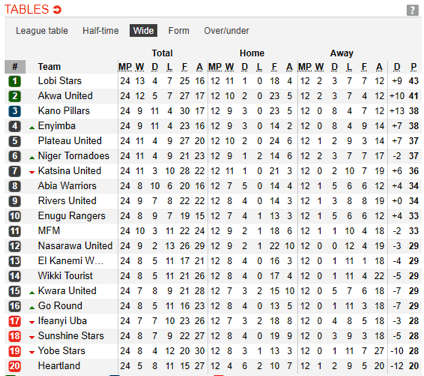
Opinion: How Much of a Factor is Home Advantage in the Top European Football Leagues?
I once had a pointless debate/argument with someone who suggested that home advantage wasn’t important in football. It was an absurd statement since even a cursory look at any season’s league table in any of the top four English leagues will show that the vast majority of sides pick up more points at home than away.
The question is: How significant is the home ‘edge,’ and is there a way to use it to our advantage? Before I move on to the major European leagues, NO football league in the world provides greater home advantage than the Nigerian league.
It is simply spectacular, year after year. Here’s how the full table looks just over halfway through the season:

To date, the home side has 12 defeats in 240 matches! This is normal. It is rare for any side to manage more than two away wins in a season, and the league is usually won with 60-65 points from 38 games. To be fair, Nigeria is an exception because the league is allegedly filled with corruption. From intimidation to bribery, away sides simply aren’t allowed to win.
SoccerVista has an interesting table which shows the global leagues where homefield advantage is greatest. You can view the chart here. Nigeria is #1, while Bolivia’s top three leagues also feature; primarily due to altitude. Brazil’s Serie A and Indonesia’s Liga 1 are also notable entries. What you don’t see is any of Europe’s top leagues. However, these leagues also have a home advantage; the level of which varies from country to country.
Home Advantage in the English Premier League
There have been a number of studies on the phenomenon of home advantage in England. What they have found is that the size of the edge has fallen steadily since the foundation of the Football League in 1888. The 1895/96 season saw the greatest ever percentage of home wins: 64.6%. By the 2015/16 season, only 41% of games were won by the home side in the four divisions.
Interestingly, home edge falls as you drop down the leagues. In 2015/16 for example, 49.2% of Premier League sides won at home, while only 40% of wins in League Two were by the home team. In 2017/18, the Premier League home win rate fell to just 45.52%. Away sides in the Premier League won 28.42% of the time last season.
Last season home sides scored 582 goals and conceded 436 times. That correlates to an average of 1.53 goals scored and 1.15 goals conceded, for an average goal difference of +0.38 goals per match.
In 2015, James Curley of Columbia University released research into the history of English professional football. He looked at over 200,000 matches from 127 years’ worth of football and confirmed the belief that home sides benefit from a higher proportion of penalties. Since the rebranding of the First Division in England in 1992, 66% of penalties have been awarded to the home side; it was as high as 75% at one point. Curley claims it is now around 55%.
What About Other Major European Leagues?
For the sake of the article, ‘major’ leagues in Europe are Italy’s Serie A, Spain’s La Liga, and Germany’s Bundesliga. Along with the English Premier League, these three leagues make up the top four nations in terms of UEFA coefficient, and all four receive four entries into each season’s Champions League.
Here is the 2017/18 home win rate per league:
- Italy: 43.15%
- Spain: 47.1%
- Germany: 45.42%
Germany is extremely close to England regarding home wins. Home advantage is less prominent in Italy and more noticeable in Spain. Next, let’s look at home goal advantage in each of the three leagues in 2017/18 and compare it to England’s +0.38.
- Italy: +0.24
- Spain: +0.40
- Germany: +0.41
Although Spain has the highest win rate, Germany has a bigger positive GD for home sides; an indication that the margin of victory is higher in the Bundesliga. However, in the last five seasons, La Liga has had by far the highest positive GD for home sides amongst the four leagues with 0.44, against the 0.39 in Germany, 0.38 in England, and 0.33 in Italy.
A Steady Decline
One of the most interesting aspects of study into a home advantage is its gradual level of decline in all four major European leagues. Pinnacle Sport performed a detailed analysis of home win percentage implied by the site’s closing line odds. It is an organisation that prides itself on providing the most accurate odds in the industry.
Over the last five seasons, this average ‘implied’ win percentage was as follows:
- England: 44.44%
- Italy: 45.28%
- Spain: 47.02%
- Germany: 44.88%
Barring the Premier League which was just 0.1% higher than the next worst season, all of the leagues had their worst season for home sides in 2017/18. If we were to take Pinnacle’s closing line odds as Gospel, punters would have had a slight edge by backing all English Premier League sides at home last season (45.52% win rate versus implied odds line percentage of 43.8%).
You would be at a 1.15% disadvantage in Serie A but would benefit from slight edges of 0.8% in La Liga and 1.32% in Germany.
What Are the Reasons for Home Advantage?
Football fans are often fond of laying the blame solely at the door of the referee. Although this is often unfair, it is ridiculous to suggest that a single official is NOT swayed by 40,000+ screaming fans. Assuming there is no conscious bias, there is almost certainly a ‘subconscious’ bias. On the other hand, some referees go too far in the other direction and give the home side few 50/50 decisions for fear of being perceived as biased.
The significant reduction in the percentage of penalty kicks awarded to home sides suggests that more referees are giving into this fear, or else they are becoming more capable of drowning out crowd noise. Cynics would suggest that in the modern era, football fans are less vociferous and therefore, less likely to influence officials.
There is also a tactical reason. Even excellent teams such as Man City, Real Madrid, Juventus, and Bayern Munich score fewer goals away from home. Although the top sides may dominate many away games against lesser opposition, the home side, often emboldened by the home crowd, will give a little extra and make it tougher for the star-studded away side to score.
The advent of professionalism and the influx of cash in the game has reduced the edge enjoyed by the home side. One can imagine the travel arrangements of a semi-professional English side in the early 20th century! Today, the pampered professionals are transported via luxury coach, or the occasional plane ride, and are unlikely to suffer from a dip in performance because they had to travel for three hours!
Can I Use This Information to Increase My Bank Balance?
As you probably expect, the bookmakers have the market squeezed as tight as a drum. Your main goal should be to find individual team value. This season, Newcastle are the bottom side in the league to date but are Southampton value to win at home at odds of Evens? They are a side on the slide with just 10 home wins in the last 40 games!
West Ham have improved this season, but Leicester are arguably decent value at 11/10 since the Foxes have won 38 of the 80 home matches played since the beginning of the 2014/15 season. Without the data readily to hand, one would imagine that their home record against non-top-6 opposition is even better.
Another possibility is to use the Asian Markets (I will discuss this type of bet in a future article) to take advantage of the positive home GD on offer.
Overall, however, you will, once again, probably receive better value in lower league football across Europe. The home win rate in League 1 and League 2, for example, is routinely lower than in the Premier League. While this doesn’t always translate into value, it does mean that away sides are sometimes overpriced while the odds of home sides are too short.
For example, should a team with one home win from seven games be 7/5 to win against a team with one away loss in seven games? Probably not.
In conclusion, while there is still a prominent home advantage in professional football leagues across Europe, it is closing by the season. The bookies will change odds to reflect this new normal, but perhaps you can give them a black eye during this transition period.
Ready to take your betting from amateur to professional status? It's never been easier to upgrade your betting with the complete betting portfolio solution from Football Advisor.
Free Report:
Step by step guiding to building a successful and profitable betting portfolio. Download for free here
Weekly Best Bets:
It is designed to be a really easy and enjoyable service to follow along with just a couple of emails a week and a handful of well researched and supported bets recommended to you each week. If this sounds like something you'd enjoy why not join us for the full European season for just £9.95 a month or £77 for the whole season.

Jon is the Founder and Chief Tipster at Football Advisor and Predictoloy. He started life as data analyst in the digital marketing field before find his true calling in the world of Football and Horse Racing Betting.
Jon has been sharing his professional expertise since 2009 and specialises in using objective data analysis and subjective experience of betting built up over more than a decade of professional betting.
In 2014, Jon also launched (and continues to run) the trusted Football Advisor service service which provides a variety of football and horse racing betting models and portfolios. A few years later, Jon launched the Predictology platform which is the worlds first betting system builder and analyser covering a wealth of football betting related statistics covering more than 200,000 matches.
Jon has also lent his knowledge and expertise to several of the trusted Premium Services offered by the respected Secret Betting Club, including Football Lay Profits. Racing Bet Profits and, most recently, Racing Lay Profits.


